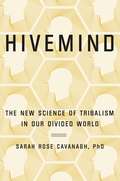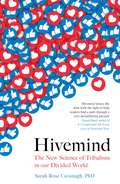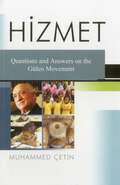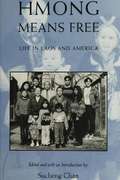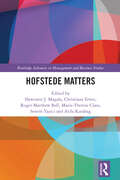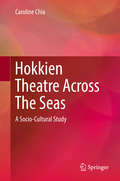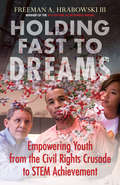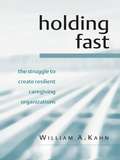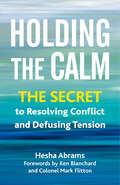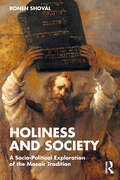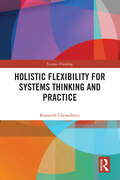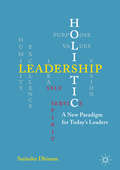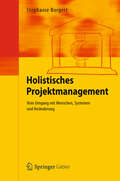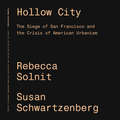- Table View
- List View
Hivemind: The New Science of Tribalism in Our Divided World
by Sarah Rose CavanaghAt the crossroads between The Shallows and Presence, Hivemind is a provocative look at how communities can sync up around shared ideas, and how this hive mentality is contributing to today's polarized times. Hivemind: A collective consciousness in which we share consensus thoughts, emotions, and opinions; a phenomenon whereby a group of people function as if with a single mind. Our views of the world are shaped by the stories told by our self-selected communities. Whether seeking out groups that share our tastes, our faith, our heritage, or other interests, since the dawn of time we have taken comfort in defining ourselves through our social groups. But what happens when we only socialize with our chosen group, to the point that we lose the ability to connect to people who don't share our passions? What happens when our tribes merely confirm our world view, rather than expand it? We have always been a remarkably social species-our moods, ideas, and even our perceptions of reality synchronize without our conscious awareness. The advent of social media and smartphones has amplified these tendencies in ways that spell both promise and peril. Our hiveish natures benefit us in countless ways-combatting the mental and physical costs of loneliness, connecting us with collaborators and supporters, and exposing us to entertainment and information beyond what we can find in our literal backyards. But of course, there are also looming risks-echo chambers, political polarization, and conspiracy theories that have already begun to have deadly consequences. Leading a narrative journey from the site of the Charlottesville riots to the boardrooms of Facebook, considering such diverse topics as zombies, neuroscience, and honeybees, psychologist and emotion regulation specialist Sarah Rose Cavanagh leaves no stone unturned in her quest to understand how social technology is reshaping the way we socialize. It's not possible to turn back the clocks, and Cavanagh argues that there's no need to; instead, she presents a fully examined and thoughtful call to cut through our online tribalism, dial back our moral panic about screens and mental health, and shore up our sense of community. With compelling storytelling and shocking research, Hivemind is a must-read for anyone hoping to make sense of the dissonance around us.
Hivemind: The New Science of Tribalism in Our Divided World
by Sarah Rose CavanaghCavanagh brings you along on her journey through an exquisite collection of scholarly knowledge and empirical insight to ground both your mind and your gut. From zombies to bees, moral panics to conspiracy theories, Hivemind mixes the dark with the light to help readers find a path through a very destabilizing present' - Danah Boyd, author of It's Complicated: The Social Lives of Networked Teens'This fascinating book guides us through the nuanced landscape of why we think and behave the way we do-online and off-and offers a much-needed vision for how we can find our way back from the edge'- Scott Barry Kaufman, Psychologist at Columbia University and co-author of Wired to Create'Hivemind provides a fascinating tour of research that reveals our social nature, for good and for bad. Cavanagh is a natural teacher whose enthusiasm for psychology shines through on every page. Whether you're looking to have healthier technology habits, develop better relationships with others, or address societal challenges, this book will give you food for thought and wisdom to take action' - Kelly McGonigal, author of The Joy of Movement and The Willpower Instinct+++Hivemind: A collective consciousness in which we share consensus thoughts, emotions, and opinions; a phenomenon whereby a group of people function as if with a single mind.Our views of the world are shaped by the stories told by our self-selected communities. Whether seeking out groups that share our tastes, our faith, our heritage, or other interests, since the dawn of time we have taken comfort in defining ourselves through our social groups. But what happens when we only socialize with our chosen group, to the point that we lose the ability to connect to people who don't share our passions? What happens when our tribes merely confirm our world view, rather than expand it? Leading a narrative journey from the site of the Charlottesville riots to the boardrooms of Facebook, considering such diverse topics as zombies, neuroscience, and honeybees, psychologist and emotion regulation specialist Sarah Rose Cavanagh leaves no stone unturned in her quest to understand how social technology is reshaping the way we socialize. It's not possible to turn back the clocks, and Cavanagh argues that there's no need to; instead, she presents a fully examined and thoughtful call to cut through our online tribalism, dial back our moral panic about screens and mental health, and shore up our sense of community. With compelling storytelling and shocking research, Hivemind is a must-read for anyone hoping to make sense of the dissonance around us.
Hizmet in Transitions: European Developments of a Turkish Muslim-Inspired Movement
by Paul WellerIn this open-access monograph, Paul Weller explores how the movement known as Hizmet (meaning “service”) is undergoing a period of transitions in Europe. Inspired by the teaching and practice of the Turkish Islamic scholar, Fethullah Gülen, Hizmet has been active in Europe (and other continents) for several decades. It has always been subject to some degree of contestation, which has intensified following the July 2016 coup attempt in Turkey, for which the current Turkish government holds Fethullah Gülen and Hizmet as responsible – a claim they strongly deny. In Turkey, thousands of people associated with Hizmet have been imprisoned. In Europe, pressures have been brought to bear on the movement and its activities. In charting a way forward, Hizmet finds itself in a significant transitional period, the nature and possible future trajectories of which are explored in this volume. The book is informed by a comprehensive literature review and a recent research project which includes primary research interviews with key Hizmet figures in Europe and beyond. It contends that to properly understand Hizmet in Europe, one has to situate it in its interactive engagement both with its diverse European national contexts and with Fethullah Gülen’s teaching and practice.
Hizmet: Questions and Answers on the Hizmet Movement
by Muhammed Cetin&“Hizmet&”—or the Gülen Movement referring to name of the renowned Turkish scholar Fethullah Gülen—originated in 1970s&’ Turkey as a faith-inspired initiative to improve educational opportunities for a local community; since then, it has grown into a transnational educational, inter-cultural and interfaith movement. This book is intended to summarize and represent the conclusions of much of the academic work on Hizmet in a manner more easily accessible to the lay person or non-specialist.
Hmong Means Free: Life in Laos and America
by Sucheng ChanThis collection of evocative personal testimonies by three generations of Hmong refugees is the first to describe their lives in Laos as slash-and-burn farmers, as refugees after a Communist government came to power in 1975, and as immigrants in the United States. Reflecting on the homes left behind, their narratives chronicle the difficulties of forging a new identity. From Jou Yee Xiongs Life Story: ""I stopped teaching my sons many of the Hmong ways because I felt my ancestors and I had suffered enough already. I thought that teaching my children the old ways would only place a burden on them. ""From Ka Pao Xiongs (Jou Yee Xiongs son) Life Story: ""It has been very difficult for us to adapt because we had no professions or trades and we suffered from culture shock. Here in America, both the husband and wife must work simultaneously to earn enough money to live on. Many of our children are ignorant of the Hmong way of life. . . . Even the old people are forgetting about their life in Laos, as they enjoy the prosperity and good life in America. ""From Xang Mao Xiongs Life Story: ""When the Communists took over Laos and General Vang Pao fled with his family, we, too, decided to leave. Not only my family, but thousands of Hmong tried to flee. I rented a car for thirty thousand Laotian dollars, and it took us to Nasu. . . . We felt compelled to leave because many of us had been connected to the CIA. . . . Thousands of Hmong were traveling on foot. Along the way, many of them were shot and killed by Communist soldiers. We witnessed a bloody massacre of civilians. ""From Vue Vangs Life Story: ""Life was so hard in the Thai refugee] camp that when we found out we could go to the United States, we did not hesitate to grasp the chance. We knew that were we to remain in the camp, there would be no hope for a better future. We would not be able to offer our children anything better than a life of perpetual poverty and anguish. ""
Hobos, Hustlers, and Backsliders: Homeless in San Francisco
by Teresa GowanWinner of the 2011 Robert Park Award for the Best Book in Community and Urban Sociology, American Sociological Association, 2011Co-winner of the 2011 Mary Douglas Prize for Best Book in the Sociology of Culture, American Sociological Association, 2011 When homelessness reemerged in American cities during the 1980s at levels not seen since the Great Depression, it initially provoked shock and outrage. Within a few years, however, what had been perceived as a national crisis came to be seen as a nuisance, with early sympathies for the plight of the homeless giving way to compassion fatigue and then condemnation. Debates around the problem of homelessness—often set in terms of sin, sickness, and the failure of the social system—have come to profoundly shape how homeless people survive and make sense of their plights. In Hobos, Hustlers, and Backsliders, Teresa Gowan vividly depicts the lives of homeless men in San Francisco and analyzes the influence of the homelessness industry on the streets, in the shelters, and on public policy. Gowan shows some of the diverse ways that men on the street in San Francisco struggle for survival, autonomy, and self-respect. Living for weeks at a time among homeless men—working side-by-side with them as they collected cans, bottles, and scrap metal; helping them set up camp; watching and listening as they panhandled and hawked newspapers; and accompanying them into soup kitchens, jails, welfare offices, and shelters—Gowan immersed herself in their routines, their personal stories, and their perspectives on life on the streets. She observes a wide range of survival techniques, from the illicit to the industrious, from drug dealing to dumpster diving. She also discovered that prevailing discussions about homelessness and its causes—homelessness as pathology, homelessness as moral failure, and homelessness as systemic failure—powerfully affect how homeless people see themselves and their ability to change their situation. Drawing on five years of fieldwork, this powerful ethnography of men living on the streets of the most liberal city in America, Hobos, Hustlers, and Backsliders, makes clear that the way we talk about issues of extreme poverty has real consequences for how we address this problem—and for the homeless themselves.
Hochachtsamkeit: Über unsere Grenze des Ressortdenkens (essentials)
by Jan-Philipp Küppers E. W. Udo KüppersDieses Essential vermittelt einen grundlegenden Einblick in die Hochachtsamkeit als Ressortgrenzen überwindende Art zu denken und zu handeln. An wachsenden Krisenherden und Umbruchsituationen in Gesellschaft und Politik sind Organisationen, ihre Strukturen und Abläufe nicht gänzlich unbeteiligt. Die Autoren erläutern auf leicht verständliche Weise, welchen Wert Hochachtsamkeit für Problemlösungen bietet und welche Rolle dabei ein besseres Verständnis von Organisationsstrukturen und darin stattfindenden Arbeitsprozessen einnimmt.
Hochqualifizierte Transmigrantinnen: Bildungswege und Migrationserfahrungen zwischen Befremdung und Beheimatung (Interkulturelle Studien)
by Nora WarrachAn der Gruppe türkeistämmiger hochqualifizierter Frauen, die ein transnationales Leben zwischen Deutschland und der Türkei führen, wird nachgezeichnet, wie sie vor ihrem Bildungshintergrund mit Befremdungserfahrungen umgehen und wie sie Beheimatungsstrategien entwerfen. Der Einblick in die Biographien der hochqualifizierten Transmigrantinnen zeigt, dass sich „Zugehörigkeitsgrenzen“ verschieben und „Werte-Patchworks“ entstehen. Gerade ihre Erfahrungen der Etikettierung als „Fremde“ nehmen sie als Chance denn als Schicksal wahr, die letztlich als Motor für ihr Streben nach Selbstverwirklichung fungieren. Damit brechen sie stereotypisierte Bilder über türkeistämmige Frauen auf.
Hochschulorganisation und Digitalisierung: Die Auswirkungen organisationaler Funktionslogiken auf die digitale Transformation an Universitäten
by Marcel Graf-SchlattmannDas Forschungsfeld zur Digitalisierung im Hochschulwesen weist eine zentrale Lücke auf: Die Auswirkungen der organisationalen Rahmenbedingungen auf die digitale Transformation. Ausgehend von der Grundannahme, dass die digitale Transformation nicht organisationsneutral erfolgt, werden die organisationalen Effekte der Universität auf den digitalen Veränderungsprozess im Spannungsverhältnis von akademischer Selbst- und universitärer Zentralverwaltung betrachtet. Hierfür wird mit einem systemtheoretischen Organisationsverständnis sowie einer äquivalenzfunktionalistischen Theorietechnik operiert und eine Beschreibung der organisationalen Funktionslogiken, ausgehend vom Bezugsproblem unklarer rationaler Technologien in Forschung und Lehre, entwickelt.Der Einbezug organisationaler Funktionslogiken erzeugt ein weiterführendes Verständnis der digitalen Transformation an Universitäten. Diese erfolgt im Sinne einer graduellen Transformation und ist durch eine Vielzahl unterschiedlicher, lose gekoppelter Prozesse und Entwicklungen gekennzeichnet. Neben der Art der Transformation und dessen organisationalen Bedingungen stehen insbesondere die Muster der Koordination organisationaler Prozesse und deren Auswirkungen auf beiden Seiten der Doppelhierarchie im Fokus.
Hoffnungs-Gründe: Begründet hoffen lernen in herausfordernden Zeiten
by Christian EllweinHoffnung in stürmischen Zeiten – Warum wir Grund zur Zuversicht haben Krisen, Kriege, Klimawandel – unsere Welt wirkt oft aus den Fugen geraten. Doch dieses Buch macht Mut: Es zeigt anhand historischer Beispiele, dass solche Umbrüche kein neues Phänomen sind – und dass Menschen in der Geschichte immer wieder Wege gefunden haben, damit umzugehen. Faktenbasiert und inspirierend zeigt der Autor auf, wie Menschen in der Vergangenheit Herausforderungen gemeistert haben – und was wir heute daraus lernen können. Hoffnung ist dabei nicht nur ein Gefühl, sondern eine Kraft, mit der wir aktiv unsere Gegenwart und Zukunft gestalten können. Dieses Buch bietet konkrete Impulse: Wie wir unsere Resilienz stärken, unsere Selbstwirksamkeit entfalten und Hoffnung in Taten verwandeln – im persönlichen Leben ebenso wie in Politik und Wirtschaft. Es lädt dazu ein, nicht zu verzweifeln, sondern zu handeln. Ein inspirierender Begleiter für alle, die sich nach Orientierung sehnen – und bereit sind, selbst Teil der Lösung zu sein. Mit Geleitwort von Herrn Dr. Andreas Krafft, der als Psychologe an der Universität St. Gallen u.a. das „Hoffnungsbarometer&“ verfasst.
Hofstede Matters (ISSN)
by Sławomir J. Magala Marie-Therese Claes Christiane Erten Roger Matthew Bell Senem Yazici Atila KarabagHofstede Matters offers an updated presentation of the evolving views of academics and teachers who have worked with Hofstede’s research findings since the publication of the first edition of Culture’s Consequences in 1980. The authors reflect on their changing beliefs about the concept of cultural dimensions that led to a radical change in the way cultures were dealt with in business schools across Europe and beyond. Hofstede’s dimensions made "thinking" about culture more accessible overnight by creating a conceptual framework that teachers, students, managers, and consultants could grasp and easily apply in international comparisons. The book shows the man behind the value dimensions framework through the eyes of teachers and academics many of whom dealt with Hofstede personally. Contemporary contributors as well as younger academic fellow researchers evaluate the past paradigms and look behind the scenes to better understand the developments of the more recent ones. Jointly, they try to decide if Hofstede still helps us to overcome uncertainty when confronted with actions undertaken with different values in mind. Did he nudge us in the desirable direction? Offering a unique analysis of the strengths, criticisms, and legacy of Hofstede’s work, this book will appeal to academics and students across disciplines including cross-cultural management, critical management studies, and international management.
Hohes Alter in Deutschland (Schriften zu Gesundheit und Gesellschaft - Studies on Health and Society #8)
by Michael Wagner Clemens Tesch-Römer Julia Simonson Roman Kaspar Susanne ZankDies ist ein Open-Access-Buch.Trotz des schnellen Wachstums des Anteils der Bevölkerung in einem Alter ab 80 Jahren an der Gesamtbevölkerung ist das Wissen über diese Bevölkerungsgruppe bislang gering. Zwar gibt es thematisch, methodisch und regional spezifische Studien, jedoch keine repräsentative Erfassung der Lebenssituation und Lebensqualität dieser Altersgruppe für den gesamtdeutschen Raum. Eine gute Datenlage ist jedoch notwendig: Zum einen, um den besonderen Unterstützungsbedarfen im hohen Alter zukünftig besser gerecht werden zu können. Zum anderen, um Lösungsansätze für sozialpolitische Herausforderungen wie der sozialen Sicherung im Alter sowie im Hinblick auf eine Generationengerechtigkeit entwickeln zu können. Schließlich, um negativen Altersbildern und Vorurteilen über die Lebensqualität im hohen Alter empirisch fundiert entgegenwirken zu können. Die Studie "Hohes Alter in Deutschland“ (D80+) ist eine bundesweit repräsentative Querschnittsbefragung der hochaltrigen Menschen in Privathaushalten und in Heimen. Sie wird vom Bundesministerium für Familie, Senioren, Frauen und Jugend (BMFSFJ) gefördert und gemeinsam vom Cologne Center for Ethics, Rights, Economics, and Social Sciences of Health (ceres) und dem Deutschen Zentrum für Altersfragen (DZA) durchgeführt. Die Studie vereint Perspektiven der an den beteiligten Institutionen verorteten Disziplinen wie Soziologie, Psychologie, Versorgungswissenschaften, Gerontologie und Medizin. Im vorliegenden Band werden zentrale Befunde u.a. zu den Themenbereichen Soziale und Digitale Teilhabe, Gesundheit und Versorgung, sowie Werte und subjektives Wohlbefinden vorgestellt.
Hokkien Theatre Across The Seas: A Socio-Cultural Study
by Caroline ChiaThis book adopts a refreshing approach by examining Hokkien theatre in a region connected by maritime networks, notably southern Fujian, Taiwan, Kinmen and Singapore. It considers how regional theatre is shaped by broader socio-cultural and political contexts and the motivation to stay relevant in an era of modernisation and secularisation. Political domains are often marked out by land boundaries, but the sea concept denotes fluidity, allowing theatrical forms to spread across these ‘land-bounded’ societies and share a common language and culture."This is an insightful theatrical study on the web of Chinese cultural networks in southern China and Singapore, and by extension, between China and Southeast Asia in the twentieth century and beyond. Using diverse sources in multiple languages and extensive field ethnography, this is a ground-breaking study which is both didactic and inspiring."- Lee Tong Soon, author of Chinese Street Opera in Singapore (University of Illinois, 2009)."Focusing on Hokkien theatre, this book offers new insights into how Chinese performing art responds to geographical, temporal, and social changes. Historical sources in different languages are widely used to give access to the cultural characteristics of Hokkien theatre, offering valuable ethnographic reports on the contemporary practices of Hokkien theatre in Taiwan, Kinmen, and Singapore. The book comments on the changing ritualistic significance of Hokkien theatre, and help us understand how societies remember the past of a performing tradition, and shape its present."- Luo Ai Mei, Co-Editor of A Preliminary Survey of the Cantonese Eight Song Cycles in South China: History and Sources (2016)
Holacracy: The New Management System for a Rapidly Changing World
by Brian J. RobertsonHolacracy is a revolutionary management system that redefines management and turns everyone into a leader. Holacracy distributes authority and decision-making throughout an organization, and defines people not by hierarchy and titles, but by roles. Holacracy creates organizations that are fast, agile, and that succeed by pursuing their purpose, not following a dated and artificial plan. This isn't anarchy – it's quite the opposite. When you start to follow Holacracy, you learn to create new structures and ways of making decisions that empower the people who know the most about the work you do: your frontline colleagues.
Hold Successful Meetings (Penguin Business Experts Series)
by Caterina KostoulaMeetings allow us to bring people together to inspire each other, solve problems and make a difference. Yet, we all spend too much time in dull, frustrating meetings where little is achieved and even less is followed up on afterwards. In Hold Successful Meetings, executive coach and former Google leader Caterina Kostoula will change all this. Her unique framework will:- Equip you to hold fewer, more purposeful meetings- Create a creative and inclusive environment- Leave participants inspired and ready to take actionWhether virtual or in-person, people will leave your meetings inspired by the value you created together and ready to make an impact.'I bought this for my whole team at Google!' Reader review
Holding Fast to Dreams
by Freeman A. Hrabowski IIIAn education leader relates how his experiences with the civil rights movement led him to develop programs promoting educational success in science and technology for African Americans and others. When Freeman Hrabowski was twelve years old, a civil rights leader visited his Birmingham, Alabama, church and spoke about a children's march for civil rights and opportunity. That leader was the Reverend Martin Luther King Jr., and that march changed Hrabowski's life. Until then, Freeman was a kid who loved school and solving math problems. Although his family had always stressed the importance of education, he never expected that the world might change and that black and white students would one day study together. But hearing King speak changed everything for Hrabowski, who convinced his parents that he needed to answer King's call to stand up for equality. While participating in the famed Children's Crusade, he spent five terrifying nights in jail--during which Freeman became a leader for the younger kids, as he learned about the risk and sacrifice that it would take to fight for justice. Hrabowski went on to fuse his passion for education and for equality, as he made his life's work inspiring high academic achievement among students of all races in science and engineering. It also brought him from Birmingham to Baltimore, where he has been president of the University of Maryland, Baltimore County for more than two decades. While at UMBC, he co-founded the Meyerhoff Scholars Program, which has been one of the most successful programs for educating African Americans who go on to earn doctorates in the STEM disciplines. In Holding Fast to Dreams, Hrabowski recounts his journey as an educator, a university president, and a pioneer in developing successful, holistic programs for high-achieving students of all races.From the Hardcover edition.
Holding Fast: The Struggle to Create Resilient Caregiving Organizations
by William A. KahnHow can caregivers remain both caring and strong enough to withstand the stress of their work?How can caregiving organizations effectively improve their management and practice?Increasing pressure on caregiving organizations to serve more people with fewer resources means that epidemics of burnout, high staff turnover, dissatisfaction and internal conflict often appear inevitable. Holding Fast focuses on the particular stress of caregiving work, its influences on the people and organizations who do that work, and what they can do about it. Illustrated by case studies based on extensive research in schools, hospitals, social work agencies, health care centres and religious institutions, Holding Fast identifies the problems faced by caregiving organizations, and outlines appropriate strategies for tackling these to create a resilient, effective organization. The book is divided into clear sections covering: * an introduction to the nature of caregiving organizations* the disturbances that can occur within them*the skills required to effectively lead them.Holding Fast offers a portrait of how organizations become, or are prevented from becoming, systems of caregiving. It will help leaders of caregiving organizations and their staff gain a better understanding of the difficulties encountered by their organizations, leading to improved management and practice.
Holding It Together: How Women Became America's Safety Net
by Jessica CalarcoOther countries have social safety nets. The U.S. has women. Holding It Together chronicles the causes and dire consequences.America runs on women—women who are tasked with holding society together at the seams and fixing it when things fall apart. In this tour de force, acclaimed Sociologist Jessica Calarco lays bare the devastating consequences of our status quo. Holding It Together draws on five years of research in which Calarco surveyed over 4000 parents and conducted more than 400 hours of interviews with women who bear the brunt of our broken system. A widowed single mother struggles to patch together meager public benefits while working three jobs; an aunt is pushed into caring for her niece and nephew at age fifteen once their family is shattered by the opioid epidemic; a daughter becomes the backstop caregiver for her mother, her husband, and her child because of the perceived flexibility of her job; a well-to-do couple grapples with the moral dilemma of leaning on overworked, underpaid childcare providers to achieve their egalitarian ideals. Stories of grief and guilt abound. Yet, they are more than individual tragedies. Tracing present-day policies back to their roots, Calarco reveals a systematic agreement to dismantle our country&’s social safety net and persuade citizens to accept precarity while women bear the brunt. She leads us to see women's labor as the reason we've gone so long without the support systems that our peer nations take for granted, and how women&’s work maintains the illusion that we don't need a net. Weaving eye-opening original research with revelatory sociological narrative, Holding It Together is a bold call to demand the institutional change that each of us deserves, and a warning about the perils of living without it.
Holding Up More Than Half the Sky: Chinese Women Garment Workers in New York City, 1948-92
by Xiaolan BaoIn 1982, twenty thousand Chinese American garment workers--mostly women--went on strike in New York's Chinatown and forced Chinese garment industry employers in the city to sign a union contract. In this pioneering study, Xiaolan Bao penetrates to the heart of Chinese American society to explain how this militancy and organized protest, seemingly so at odds with traditional Chinese female behavior, came about. Blending poignant and dramatic personal stories culled from over a hundred interviews with a detailed history of the garment industry, Chinese immigrant labor, and the Chinese community in New York, Bao shows how the participation of married women in wage-earning labor outside the home profoundly transformed their image and relationships.
Holding the Calm: The Secret to Resolving Conflict and Defusing Tension
by Hesha AbramsHolding the Calm is a practical and immediately useful guide that meticulously lays out twenty concrete, easy-to-use tools for defusing tension, settling cases, resolving disputes, and rechanneling arguments.How do you stop conflict? Settle disputes? Handle someone who is yelling at you, crying, or just won't speak? How do you find a solution when a solution seems impossible? Holding the Calm shares the secrets that enable everyone to avoid, minimize, or resolve conflict.Popular master mediator Hesha Abrams has tens of thousands of hours in the trenches mediating human conflict, and she shares her pragmatic wisdom in digestible bites that detail how to improve situations and solve difficult problems between human beings, from family and workplace disputes to complex commercial and global conflicts. Learn how to Speak into the ears that hear you Be the grown-up in the room Listen to what is not said Create small, winnable victoriesPractical, inspirational, and full of accessible tools you can use right now, Holding the Calm proves that you don't need an advanced degree or certification to minimize challenges and defuse tension between real people, businesses, and countries.
Holiness and Society: A Socio-Political Exploration of the Mosaic Tradition
by Ronen ShovalExploring the subtle political philosophy within the Biblical narrative, this book presents enduring insights that complement Ancient Greek philosophy for contemporary political distinctions – uncovering overlooked socio-political ideologies to provide a unique perspective alongside the classical philosophical tradition.By adopting a sociological approach, Ronen Shovel interprets the Bible as a reflection of perspectives and ideologies, emphasizing the intricate dynamics between rulers and subjects, balancing justice, and power within societies. A key focus is the examination of holiness as a distinct political category, influencing institutions, ethics, justice, and even the use of force. This perspective challenges traditional religious scholarship, merging sociology with the concept of holiness.Holiness and Society enriches political philosophy, religious studies, and sociology, broadening their boundaries and offering fresh perspectives, serving as a bridge between antiquity and modernity, providing valuable insights into contemporary political thought.
Holistic Flexibility for Systems Thinking and Practice (Systems Thinking)
by Rajneesh ChowdhuryThis book explores how the conceptual lens of Holistic Flexibility presents new advancements in systems thinking. Systems thinking is often associated with frameworks and methodologies that often confine the discipline to academic circles in operations research and management science (OR/MS). Holistic Flexibility for Systems Thinking and Practice challenges this status-quo and talks about systems thinking as a state of mind, giving it a cognitive character.The book presents both theoretical deliberations and practitioner cases of Holistic Flexibility. The development of systems thinking in OR/MS is described leading to the latest debates on the subject and the key pillars of Holistic Flexibility are discussed in detail. A range of case studies are presented that offer a firsthand experience of Holistic Flexibility in practice. Learnings are drawn to highlight the importance of a spiritual approach in management, an understanding which is used to further develop the conceptual lens of Holistic Flexibility since it was first introduced. This book presents a range of competencies required for systems practitioners to address and respond to complex situations in an interconnected world.A bold attempt to pragmatize systems thinking and systems practice, the ideas presented in this book weave a thread between the development of the discipline, current debates, and what lies ahead. It will be highly beneficial for OR/MS researchers and graduate students who are interested in systems thinking as well as researchers interested in connecting modern management thinking and Eastern mysticism.
Holistic Leadership: A New Paradigm for Today's Leaders
by Satinder DhimanThis book suggests that the solution to the current leadership crisis lies in leaders' self-cultivation process, emanating from their deepest values and culminating in their contribution to the common good. Traditional approaches to leadership rarely provide any permeating or systematic framework to garner a sense of higher purpose or nurture deeper moral and spiritual dimensions of leaders. Learning to be an effective leader requires a level of personal transformation on the continuum of self, spirit, and service.Synthesizing the best of contemporary approaches to leadership in a holistic manner, this book presents a unique model of leadership that is built on the sound principles of Self-Motivation, Personal Mastery, Creativity and Flow, Emotional Intelligence, Optimal Performance, Appreciative Inquiry, Authentic Leadership, Transformational Leadership, Positive Psychology, Moral Philosophy, and Wisdom Traditions of the world. This broad interdisciplinary approach is well-suited to effectively address the multifaceted issues faced by contemporary organizations and leaders. It will be of great interest to graduate business and organizational leadership students and faculty as well as corporate leaders.
Holistisches Projektmanagement
by Stephanie BorgertViele Projekte, an denen Mitarbeiter täglich arbeiten, sind von vornherein zum Scheitern verurteilt. In dem Buch werden Erkenntnisse aus der Systemtheorie, der Hirnforschung sowie dem Neuro-Linguistischen Programmieren (NLP) in einem ganzheitlichen Ansatz zu praktischen Werkzeugen und Methoden für die Projektarbeit verknüpft. Die Autorin, die auf 15 Jahre Projekterfahrung als Mitarbeiterin, Projektleiterin, Auftraggeberin und Coach zurückblickt, versteht Projekte als komplexe dynamische Systeme, die von Menschen mit Leben gefüllt werden.
Hollow City: The Siege of San Francisco and the Crisis of American Urbanism (Haymarket Ser.)
by Rebecca SolnitReporting from the front lines of gentrification in San Francisco, Rebecca Solnit and Susan Schwartzenberg sound a warning bell to all urban residents. Wealth is just as capable of ravaging cities as poverty.
